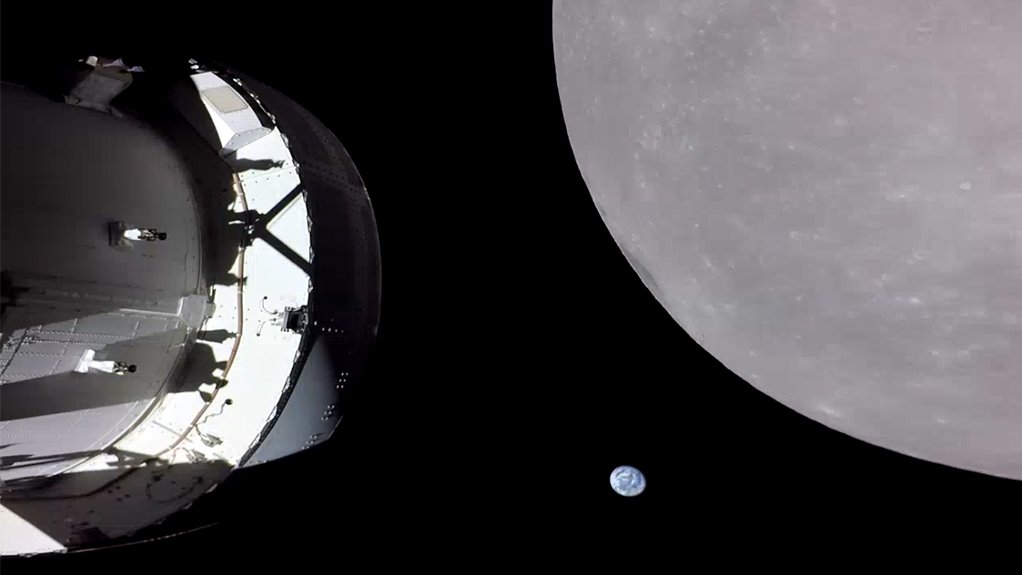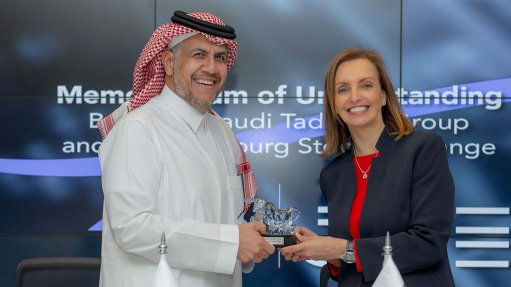Artemis I first Moon fly-by a complete success


Screen shot of a video recorded on Monday by a camera mounted on one of Artemis I’s solar panels, showing the spacecraft itself, a distant Earth, and the far side of the Moon.
Photo by Nasa
The Artemis I spacecraft successfully executed its first fly-by of the Moon on Monday, the sixth day of its mission. Led by US National Aeronautics and Space Administration (Nasa), the Artemis programme has significant international participation, most notably (but not exclusively) from the European Space Agency (ESA – which is totally separate from the European Union, although with overlapping membership). And South Africa will play a key ground support role in future missions, starting with Artemis III.
Artemis I is an uncrewed test flight of Nasa’s (indeed, humanity’s) latest crewed lunar exploration spacecraft. In fact, Artemis spacecraft – each of which is composed of the US Orion capsule and the European (Space Agency) Service Module – are designed and intended to fly far beyond the Moon. And that is what Artemis I will also do.
Artemis I passed over the Moon at a minimum distance of 81 miles (130.4 km). To achieve this, the spacecraft made four orbital trajectory burns (that is, engine firings), using its auxiliary engines. Artemis has three different types of thrusters (manoeuvring engines) – the largest being the orbital manoeuvring system engine, then the medium-sized auxiliary engines, and finally the small reaction control system thrusters. All three types have now been successfully employed operationally, in changing the spacecraft’s course, through the different manoeuvres conducted to date.
“The mission continues to proceed as we had planned, and the ground systems, our operations teams, and the Orion spacecraft continue to exceed expectations, and we continue to learn along the way about this new, deep-space spacecraft,” reported Artemis I mission manager Mike Sarafin. Interestingly, during this first lunar fly-by, Artemis I overflew the landing sites of Apollo 11 (at an altitude of about 2 253 km), Apollo 14 (at a height of some 9 656 km) and Apollo 12 (at about 12 392 km).
This lunar fly-by was the first of two manoeuvres needed to place the spacecraft in what is called a distant retrograde orbit, beyond the Moon. The second such manoeuvre, an insertion burn, will take place on Friday and put Artemis I into this orbit. Distant means that the spacecraft will go far beyond the Moon – at its highest point, its orbit will be some 64 374 km from the Moon. However, in the process of entering that orbit, Artemis I will reach a point some 92 194 km beyond the Moon. This will take it further than any spacecraft designed to carry humans has ever gone (beating the record set by Apollo 14).
Retrograde means that Artemis will orbit the Moon in the opposite direction of the Moon’s orbit around the Earth. This type of orbit has been chosen because it is very stable and so will minimise fuel expenditure (which is already less than forecast).
Comments
Press Office
Announcements
What's On
Subscribe to improve your user experience...
Option 1 (equivalent of R125 a month):
Receive a weekly copy of Creamer Media's Engineering News & Mining Weekly magazine
(print copy for those in South Africa and e-magazine for those outside of South Africa)
Receive daily email newsletters
Access to full search results
Access archive of magazine back copies
Access to Projects in Progress
Access to ONE Research Report of your choice in PDF format
Option 2 (equivalent of R375 a month):
All benefits from Option 1
PLUS
Access to Creamer Media's Research Channel Africa for ALL Research Reports, in PDF format, on various industrial and mining sectors
including Electricity; Water; Energy Transition; Hydrogen; Roads, Rail and Ports; Coal; Gold; Platinum; Battery Metals; etc.
Already a subscriber?
Forgotten your password?
Receive weekly copy of Creamer Media's Engineering News & Mining Weekly magazine (print copy for those in South Africa and e-magazine for those outside of South Africa)
➕
Recieve daily email newsletters
➕
Access to full search results
➕
Access archive of magazine back copies
➕
Access to Projects in Progress
➕
Access to ONE Research Report of your choice in PDF format
RESEARCH CHANNEL AFRICA
R4500 (equivalent of R375 a month)
SUBSCRIBEAll benefits from Option 1
➕
Access to Creamer Media's Research Channel Africa for ALL Research Reports on various industrial and mining sectors, in PDF format, including on:
Electricity
➕
Water
➕
Energy Transition
➕
Hydrogen
➕
Roads, Rail and Ports
➕
Coal
➕
Gold
➕
Platinum
➕
Battery Metals
➕
etc.
Receive all benefits from Option 1 or Option 2 delivered to numerous people at your company
➕
Multiple User names and Passwords for simultaneous log-ins
➕
Intranet integration access to all in your organisation



















